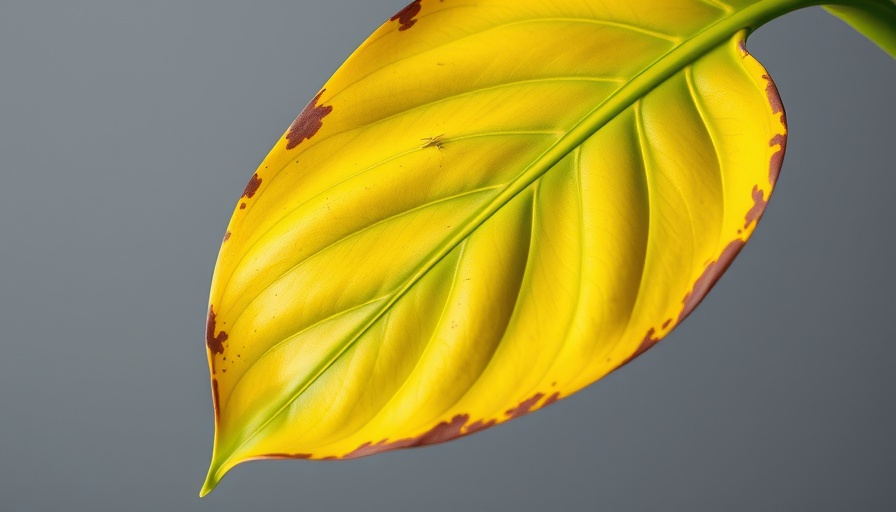
Understanding Your Monstera: A Beloved Houseplant
Monsteras have exploded in popularity as houseplants over the past few years, and for good reason. These stunning tropical plants, known as Monstera deliciosa, not only beautify our homes but also bring a sense of vitality to indoor spaces. With glossy heart-shaped leaves that develop enchanting fenestrations over time, monsteras can become striking focal points in any room. However, caring for them isn't just about watering and sunlight; attentive observation is crucial to keep them healthy and thriving.
Recognizing When Your Monstera Is Unwell
As a responsible plant parent, there may come a time when you ask yourself, "Is my monstera sick?" Understanding the signs of distress can help you take action before it's too late. Noticing yellowing leaves or drooping foliage? It’s essential to assess the plant's needs.
Megan Brame, a plant expert and host of The History of Plants podcast, highlights that yellowing leaves are often the first indicator your monstera needs help. "Drooping leaves could eventually lead to brown, crispy edges," she warns. Always keep an eye on your plant; frequent inspections can alert you to any changes. If leaves yellow from the tip inward or a higher leaf is affected, these could point to specific issues that require closer inspection.
The Importance of Light and Water: Key Factors for a Happy Monstera
Light is another critical element. A leggy monstera, characterized by elongated stems and sparse foliage, usually indicates insufficient light. Therefore, consider relocating the plant to a brighter location. Watering, on the other hand, must strike a precise balance. Overwatering can lead to root rot, while under-watering might result in crispy, brown edges on the leaves. Knowing the right amount to water can be the difference between a vibrant monstera and a struggling one.
Common Misunderstandings and Care Tips
The journey of caring for a monstera also involves navigating common misconceptions. For instance, many plant enthusiasts erroneously interpret non-fenestrating leaves as a sign of sickness. Brame explains that these splits in the leaves only appear once the plant has matured and is comfortable in its environment. Patience is essential in nurturing your monstera; not every new leaf will showcase the iconic fenestrations immediately.
And while yellowing leaves often signal trouble, don't be too quick to panic. An older leaf turning yellow may simply be a natural part of the plant's life cycle. By staying observant, you can differentiate normal aging from signs of distress.
Step-by-Step Restoration: How to Revive Your Monstera
If your monstera is exhibiting signs of illness, don’t despair! There are actionable steps you can take to help revive your plant.
- Assess Watering Practices: Check the soil moisture to determine if it's time to adjust your watering schedule.
- Optimize Lighting Conditions: Move your monstera to a brighter spot, or consider supplemental grow lights during darker months.
- Fertilization: Feed your monstera during the growing season with a balanced fertilizer to promote healthy leaf growth.
- Humidity Levels: Monstera loves humidity! Consider using a humidifier or misting the leaves regularly, especially in dry seasons.
Implementing these steps will not only improve the health of your monstera but also enhance the overall aesthetic of your home.
Future Gardening Trends: Why Monstera Will Remain Popular
As homes evolve into stylish sanctuaries, indoor plants like the monstera will remain a centerpiece. The green living trend is not just about aesthetics; it’s about promoting healthier indoor air quality and connecting with nature.
As home improvement enthusiasts, homeowners were already leaning towards sustenance, with increased interest in gardening and eco-friendly products. Incorporating houseplants into home decor fits neatly into these values, making monsteras a continuing favorite among plant parents.
In conclusion, keeping your monstera healthy is an enriching journey filled with observation, patience, and a sprinkling of love. The more you understand your plant’s needs, the more it flourishes and brightens your life. So, if you find yourself wondering about the health of your beloved monstera, take a moment to reevaluate its needs—both for the sake of the plant and for the joy it brings to your home.
For the health of your home and to learn more about appropriate care techniques that keep your indoor plants thriving, start making those small adjustments today!
 Add Row
Add Row  Add
Add 




Write A Comment